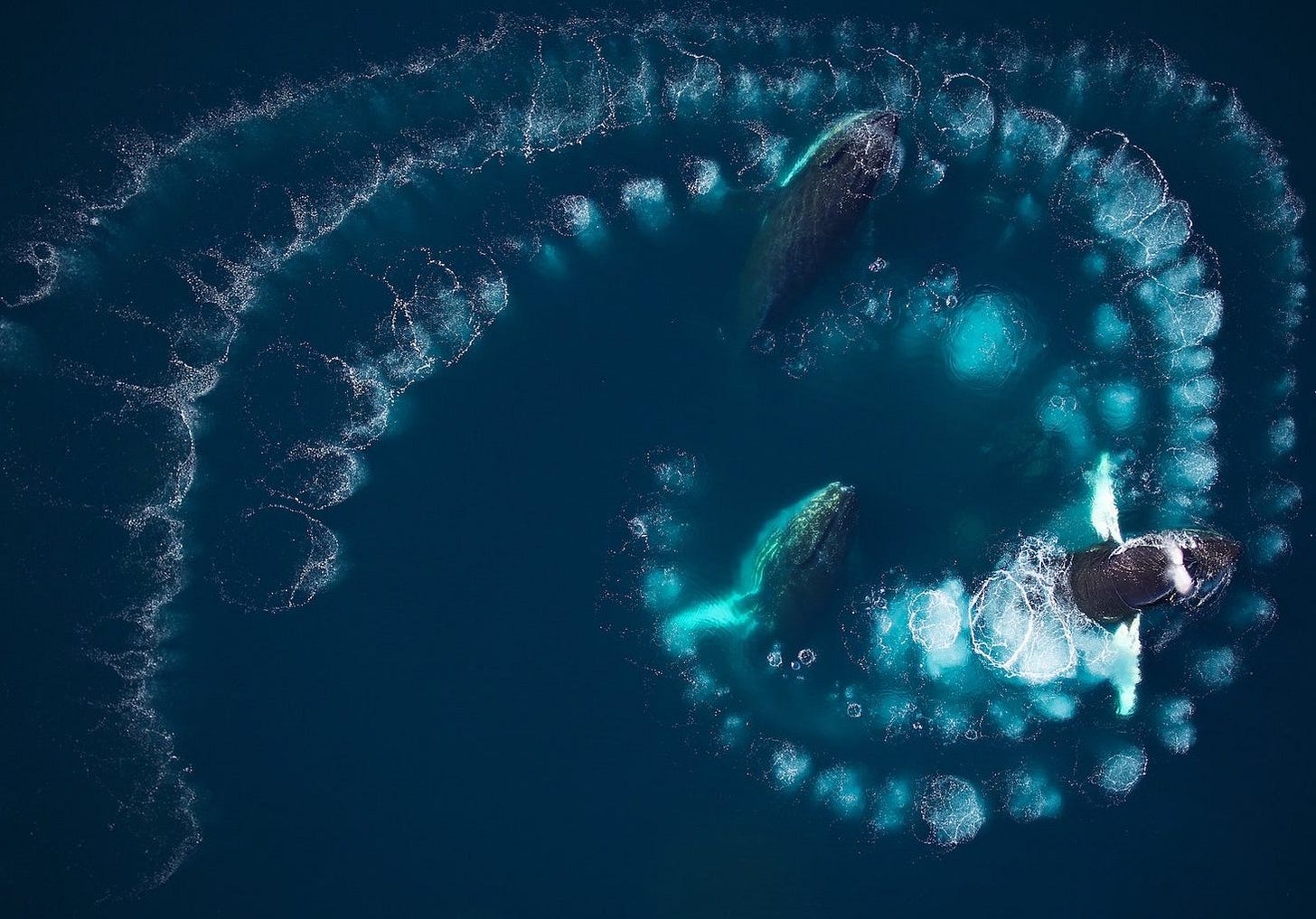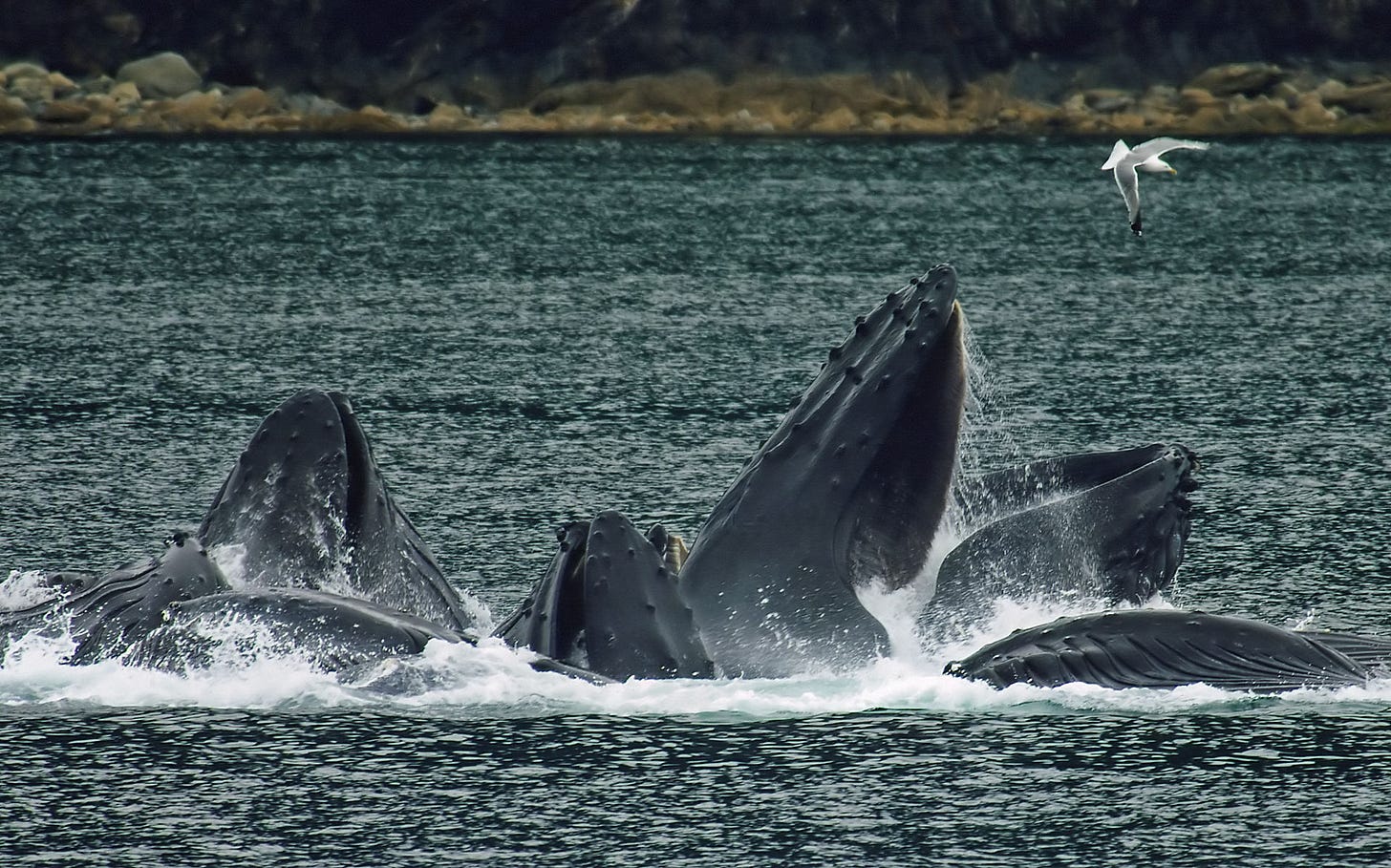What is bubble net feeding?
Deep Dives II
Welcome to another edition of Deep Dives by Beached - an in-depth exploration of everything oceanic, from scientific discoveries to marine mysteries.
Expect a bit of history, science and adventure, as we dive deep into the big blue 🤿
Whales have often been referred to as gentle giants. Beloved for their docile nature and soft touch despite being the largest animal in the ocean, with a power and strength like no other.
Humpback whales are a species particularly adept at showcasing this gentler, more nimble side to the mighty whale1, and just how important touch is to them. Capable of breaching at top speeds to rid their skin of barnacles. Lovingly embracing their calves. Rolling amongst kelp fronds as a means of mobility training. Slapping the water's surface with their dexterous fins and flukes to communicate.
Even their hunting techniques are precise, meticulous, and (sometimes) feather-light for one so giant. A perfect example of this is what is called ‘bubble net feeding’.
This sophisticated feeding method requires communication, cooperation, and a high level of social intelligence. It brings together at least three humpbacks to catch small schooling fish like herring, krill or salmon. Interestingly, this behaviour is not universal among all humpback populations and is instead a learned skill only adopted by certain groups.
Typically, a lead whale will dive beneath a school of fish and blow bubbles, by exhaling out of their blowhole, in a circular pattern. Other whales then join in, swimming around the ‘net’ in a spiral adding to the cylindrical curtain of bubbles where necessary and keeping the fish trapped. Vocalising as they go helps to coordinate their efforts and keep the group in sync. The fish caught inside this bubble net become disoriented and huddle together in a panic. This gives the whales the perfect opportunity to swim through the centre of the fish clustered at the surface with their mouths wide open, ready for a large gulp of their tasty grub. Humpbacks are sometimes referred to as ‘gulpers,’ meaning they swallow everything in their path before closing their mouths around a great mouthful. Pushing the seawater out through their baleen plates, the caught fish are gulped down whole2.
Over time, humpbacks have developed variations on this technique to adapt to different conditions. Some use pectoral herding, splashing their flippers horizontally at weak parts of the bubble net to fill in the gaps. Others have been spotted using the underside of their white flippers to reflect sunlight, causing fish to turn away from the flash of light and swim back toward their mouths.
They have also been known to change up their technique depending on the prey. For example, in one region when the abundance of herring dwindled, whales began to feed on sand lance instead. Sand lances were less panicked by the bubble vortex and so humpbacks began to beat the surface of the water with their tails, bunching the sand lance together and making the bubble net technique effective once more.
Some researchers have suggested that bubble net feeding perhaps developed as a survival strategy after humpbacks were hunted to near-extinction, allowing as many whales as possible to feed efficiently in a short amount of time.
Whatever the origin, bubble net feeding requires the ability to be both powerful and precise – qualities that define these gentle giants.
Here at Beached we are building a community that can put our brains and resources together to highlight and fund solutions to the problems facing the ocean and its inhabitants. I hope you’ll join our humble community and click subscribe for free or support our work by purchasing the paid subscription.
All Beached posts are free to read but if you can we ask you to support our work through a paid subscription. These directly support the work of Beached and allow us to engage in more conversations with experts in the field of marine conservation and spend more time researching a wider breadth of topics for the newsletters. Paid subscriptions allow us to dedicate more time and effort to creating a community and provide the space for stakeholders to come together, stay abreast of each other’s work and foster improved collaboration and coordination.
One day Beached hope to donate a large percentage of the revenue from paid subscriptions to marine conservation organisations and charities to support their work too. Working together, we can reverse the degradation of our oceans.
Amie 🐋
Bryde’s whales have also been seen bubble net feeding.
It isn’t until writing it out like this that I realised what a horror show it must be to be a fish.




